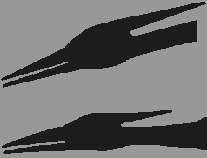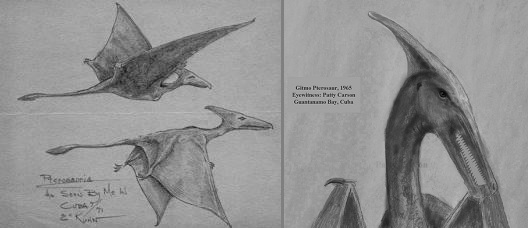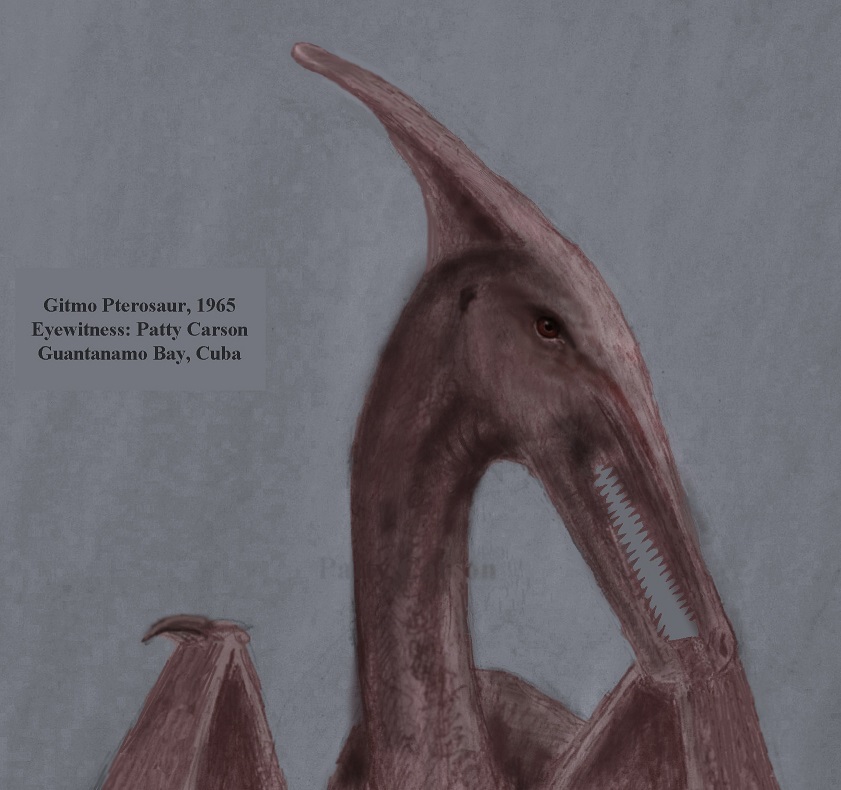By cryptozoologist Jonathan Whitcomb
In criticizing the case for modern living pterosaurs, Glen Kuban (who has at least an amateur interest in paleontology, if not a professional interest) in his web page “Living Pterosaurs?” has said:
“While finding a living species of pterosaur would be a monumental discovery, it would do nothing to refute mainstream geology.”
That statement he wrote near the beginning of his very lengthy web page, an online publication that was engineered to discredit the possibility of non-extinct pterosaurs. At the end of his lengthy page he wrote something similar:
“If living pterosaurs were someday confirmed, it would be a wonderful scientific discovery, but do nothing to undermine mainstream geology.”
I have found many problems and weaknesses in his page, but his dogmatic insistence on the validity of old concepts of geology—that in itself has weakness. Yet I have already written much, in my other publications, about the problems in “Living Pterosaurs?” by Glen Kuban, so I’ll leave most of them alone now.
How does all that relate to “The fiery flying serpent and the geologic column?” It’s the dogmatic assertion that all species of pterosaurs should have become extinct many millions of years ago. If the problem were with only one paleontologist, I would not delve into the matter. But the problem is much deeper.
.
Rock formations in Neff’s Canyon, just east of the Salt Lake Valley of Utah
.
What was the fiery flying serpent in the Bible?
I’ve written much, over many years, about a new explanation for the fiery flying serpent mentioned in the Old Testament. I’ll take a simple direct approach here. The animal that caused many deaths among the children of Israel, at the time of Moses, was a long-tailed pterosaur, a nocturnal Rhamphorhynchoid (“basal”) pterosaur with intrinsic bioluminescence.
So a “pterodactyl” was not yet extinct at the time of Moses? Precisely. And long-tailed pterosaurs are still not extinct, at least in a limited number of nocturnal species observed worldwide.
.
A North American ropen, observed in 1965 in eastern Cuba; sketch by the eyewitness
.
Modern search for a “living fossil” in Papua New Guinea
I’ve spent over 10,000 hours, over the past 14 years, in my investigation of eyewitness reports of a flying creature that most Westerners assume became extinct long ago, and I do not mean that I’ve been surfing the internet for what others have said about this subject. About one year into my research, I lead an expedition on a remote tropical island in the southwest Pacific: Umboi Island in Papua New Guinea.
I did not visit the volcanic island of Umboi to examine rock strata. I was a forensic videographer seemingly outside his normal area of investigation: searching for a flying cryptid that natives of the Kovai language call “ropen.” When I failed to see the ropen, however, I reverted back to my profession and interviewed native eyewitnesses while videotaping them. I returned to the United States late in 2004, convinced that the native eyewitnesses had told me the truth about what they had seen.
A few weeks later, two other American cryptozoologists explored the same island, interviewing mostly other natives, mostly with other techniques and procedures. My two associates came to the same conclusion: The ropen of Umboi Island is a large extant long-tailed pterosaur. Over the next twelve years, I wrote three nonfiction books on these featherless flying creatures:
- Searching for Ropens and Finding God
- Live Pterosaurs in America
- Live Pterosaurs in Australia and in Papua New Guinea
Only a small part of those writings mentioned the fiery flying serpent of the Bible, yet I did mention it in some of my web pages and blog posts. My primary concern was promoting awareness of recent eyewitness sightings of the amazing featherless flying creatures, as reports continued to come to me from various parts of the world.
A scientific paper in a peer-reviewed journal
I also wrote “Reports of Living Pterosaurs in the Southwest Pacific,” which was published by Creation Research Society Quarterly (Vol. 45, #3, Winter, 2009). The article in this journal of science is now available for anyone to investigate, if they choose. I’ll not quote from it here, but it contains much that we learned from those two expeditions in Papua New Guinea in 2004, including a few points about the glow of the nocturnal ropen.
.
Unscientific skepticism in the writings of some paleontologists
The following contains brief excerpts from online writings of some of the skeptics who have written critically of my investigation, or have criticized the work of my associates, especially some of the more negative, unscientific writings. I would not give it much attention except that these two scientists are among the more acclaimed paleontologists.
.
Donald Prothero (online post “Fake Pterosaurs and Sock Puppets”):
“… the internet has made it possible for myths and legends to spread … [they] can be intentionally distorted —especially online … so it is with cryptozoology … a single individual can create a whole mythology about a cryptid, all by himself. Such has apparently happened with the pterosaur-like cryptid … ‘ropen.’
“Brian Switek discussed … but did not spot a deception … virtually all discussion … comes from a single individual, Jonathan Whitcomb! . . . a Mormon creationist who believes [in the Bible]”
Prothero soon thereafter declares “Whitcomb admits the deception.” But I NEVER said that I used any deception. In fact, my temporary use of two pen names was to declare the truth: details about eyewitness sighting reports of apparent living pterosaurs. Why did this paleontologist write so much, in this online post, about “deception” from a person with whom he did not communicate with beforehand, a cryptozoologist who has different religious beliefs than he has? And why did he feel the need to write anything about the religious beliefs of a cryptozoologist? How unscientific!
I hope I’m not misunderstood here. I support proper scientific skepticism. But when one scientist disagrees with another scientist and proclaims that the other person has used deception—that is probably highly inappropriate, at least. In this case, we see unscientific skepticism.
.
Darren Naish (online post “Pterosaurs alive in, like, the modern day!”)
“… much of the propaganda surrounding the ropen (for example) comes from ‘young earth creationists’ who seem to think that ‘living pterosaurs’ provide support for their views …”
But in the next paragraph he includes this:
“… most accounts are tremendously vague and do not report any of the details we would need to be confident that we are dealing with real animals. … [The accounts] are often contradictory, variously describing the creatures as having bat-like, ape-like or beaked faces.”
I see a number of problems with those two paragraphs. Let’s deal with the faces.
The first, and larger, paragraph refers to young earth creationists, and the second paragraph appears to relate to that. Perhaps Naish would have done better if he had been less vague himself. The problem is this: contradictory descriptions of faces—that appears to SOMETIMES apply to the overall world of strange flying creatures of cryptozoology; it applies poorly, however, to the writings of young earth creationist cryptozoologists. Indeed, my associates and I have pointed out similarities in the descriptions of the heads in sighting reports. Note the following:

Two independent composite sketches of the ropen
Both of the above images were chosen by eyewitnesses, the top one by a man who saw a large flying creature on Bougainville Island, New Guinea. The bottom image was chosen by a man who saw a huge “pterodactyl” near Finschhafen, New Guinea.
The top image was the sketch chosen by the eyewitness Brian Hennessy (sighting in 1971). The bottom image was chosen by Duane Hodgkinson (sighting in 1944). This two-head image has been published extensively, in print format and online. I interviewed both eyewitnesses. Each man chose a head-shape without knowledge of the other man’s choice.
.

Two sketches by two eyewitnesses, both sightings in Cuba: in 1971 and in 1965
In online publications, the above two sketches are not always shown side by side, unless perhaps the web page or blog post was about pterosaur sightings in Cuba. But anyone who does a detailed online search for pterosaur sighting reports in North America—that researcher should not have much difficulty in finding these two sketches and in noticing the striking similarity of these drawings. Notice the similar heads. Neither one looks “bat-like” or “ape-like.”
The left sketch was drawn by the U.S. Marine Eskin Kuhn, now living in Ohio, soon after his sighting of two “pterodactyls” at close range, at Guantanamo Bay, Cuba, in 1971. I’ve interviewed him in recent years.
The right sketch was drawn by Patty Carson, now living in California. She saw the flying creature at close range, also at Guantanamo Bay, in 1965. She drew her sketch more recently. I’ve also interviewed her in recent years.
To the point, Darren Naish would probably have done much better if he had done more thorough research before writing about supposed problems with cryptozoological investigations by “young earth creationists.” He would probably also have done better if he had kept more to his field of paleontology.
I’m not saying that he’s 100% wrong by using the words “variously describing the creatures.” In one sense, that does fit the case of a disagreement between two scientific papers, but neither of those fits with faces looking “bat-like” or “ape-like.”
I know of only two published scientific papers on the subject of modern (non-extinct) pterosaurs:
- “The Fiery Flying Serpent” (by David Woetzel)
- “Reports of Living Pterosaurs in the Southwest Pacific” (by me, Jonathan Whitcomb)
But that difference between two images is between two kinds of Rhamphorhynchoid pterosaurs, with neither head suggesting anything bat-like or ape-like.
And I’m not saying that he’s 100% wrong in one other sense: Some online cryptozoology sites can mention cryptids that have at least sometimes been mentioned with bat-like or ape-like faces, and some of those descriptions may classify those cryptids as flying creatures. One example is the Ahool of Indonesia.
Yet I found nothing, in a brief online search, that suggests any young earth creationist has ever made any major online attempt at promoting the Ahool as a modern pterosaur. One page mentions that cryptid as a “cousin” of the ropen of Papua New Guinea, but that page shows no sign of being written by any young earth creationist.
I have written and published over a thousand web pages and blog posts on modern non-extinct pterosaurs. Among those many online publications, on rare occasions I have mentioned the Ahool and the Orang Bati, yet it seems very unlikely that Darren Naish would have stumbled upon one of those few pages. Try a Google search with “modern pterosaur” and it will be extremely unlikely that you’ll see Ahool or Orang Bati, even if you’re looking for those words.
Online searching for cryptid lists is different. You can find the Ahool and the Orang Bati on at least one of those lists, but I see no sign that any of them were written by any young earth creationist.
The Orang Bati of Seram Island
Here’s one page that I did publish under the title of “Orang Bati,” although it seems highly unlikely that Naish had seen it. Looking into the details, however, what is written on that page, it does not at all support the idea that the quest for promoting living pterosaurs mostly involves accounts that are “tremendously vague and do not report any of the details we would need to be confident that we are dealing with real animals.”
Look at my page “Orang-Bati of Seram Island” and notice the two detailed sketches near the top of that page. Further down the page you’ll see Gideon Koro, whom I interviewed while videotaping him on Umboi Island, Papua New Guinea, during my expedition in 2004. Notice his estimate of the length of the tail that he and six other eyewitnesses saw on the ropen that fly over Lake Pung in 1994: “Gideon estimated the tail length at seven meters.” How does that relate to what Darren Naish said about “tremendously vague?” I doubt he saw my page before he wrote those words.
And yet I did write a page on the Orang Bati, which has been said by some persons to be “bat-like or somewhat monkey-like.” When you read what I wrote on that page, however, my intentions can become clear. I recognized the potential mistake that some people may make with some flying cryptids in the southwest Pacific. In other words, an eyewitness could see a ropen in Indonesia and use the word “Orang Bati” in reporting the sighting. An important point in living-pterosaur investigations is not so much in a label given to the flying creature as it is in the detailed descriptions of what the animal looked like.
The geologic column does not prove universal pterosaur extinction
Now for a brief mentioning of an idea that many paleontologists may find distasteful: All the discovered fossils of pterosaurs, no matter how they are dated, cannot prove that even one of their species is extinct. To criticize or ridicule cryptozoologists for publicizing eyewitness accounts of apparent modern non-extinct pterosaurs—that criticism is not helping to promote scientific advancement.
Cryptozoological investigations are best done by enquiring crytozoologists, not unscientifically-skeptical paleontologists, regardless of all the degrees they may have in paleontology. I’m grateful for the many wonderful things that we have learned from paleontologists, including wonderful details learned by paleontologists from examining pterosaur fossils. I applaud those who continue to make progress with fossils of those flying creatures. Just please don’t try to shoot down the possibility that some species are still flying around at night, few in number but non-extinct.
Summary
In the context of countless recent sighting reports of living pterosaurs, some of which accounts include details suggesting some of the flying creatures use bioluminescence, the fiery flying serpent needs to be reconsidered:
- “Fiery” relates to a nocturnal glow of bioluminescence, not the pain of a bite
- “Flying” refers to literal flying, NOT snakes leaping out of trees
- “Serpent” comes from a superficial resemblance to snakes when the wings are folded up
###
.
What is the Fiery Flying Serpent of the Bible?
Some Bible scholars have assumed that a story of anything like a flying fire-breathing dragon could not have come from any real animal. Thus, to avoid a strange direct interpretation, we’ve been fed indirect meanings for “fiery” and “flying.” . . . In 2003, I began studying eyewitness accounts of strange flying creatures in Papua New Guinea. [The ropen, an apparent Rhamphorhynchoid pterosaur]
The Ropen of Papua New Guinea and the Fiery Flying Serpent
Do we have any interpretation that would include a clear and accurate connection between an animal that lived a few thousands of years ago and these three words: fiery, flying, and serpent? [The best explanation is that it was a long-tailed bioluminescent pterosaur, what some would call a “glowing pterodactyl”]
Misconceptions About the Geologic Column
. . . the standard geologic column was devised before 1860 by catastrophists who were creationists.1 Adam Sedgewick, Roderick Murchison, William Coneybeare, and others affirmed that the earth was formed largely by catastrophic processes, and that the earth and life were created.
.




